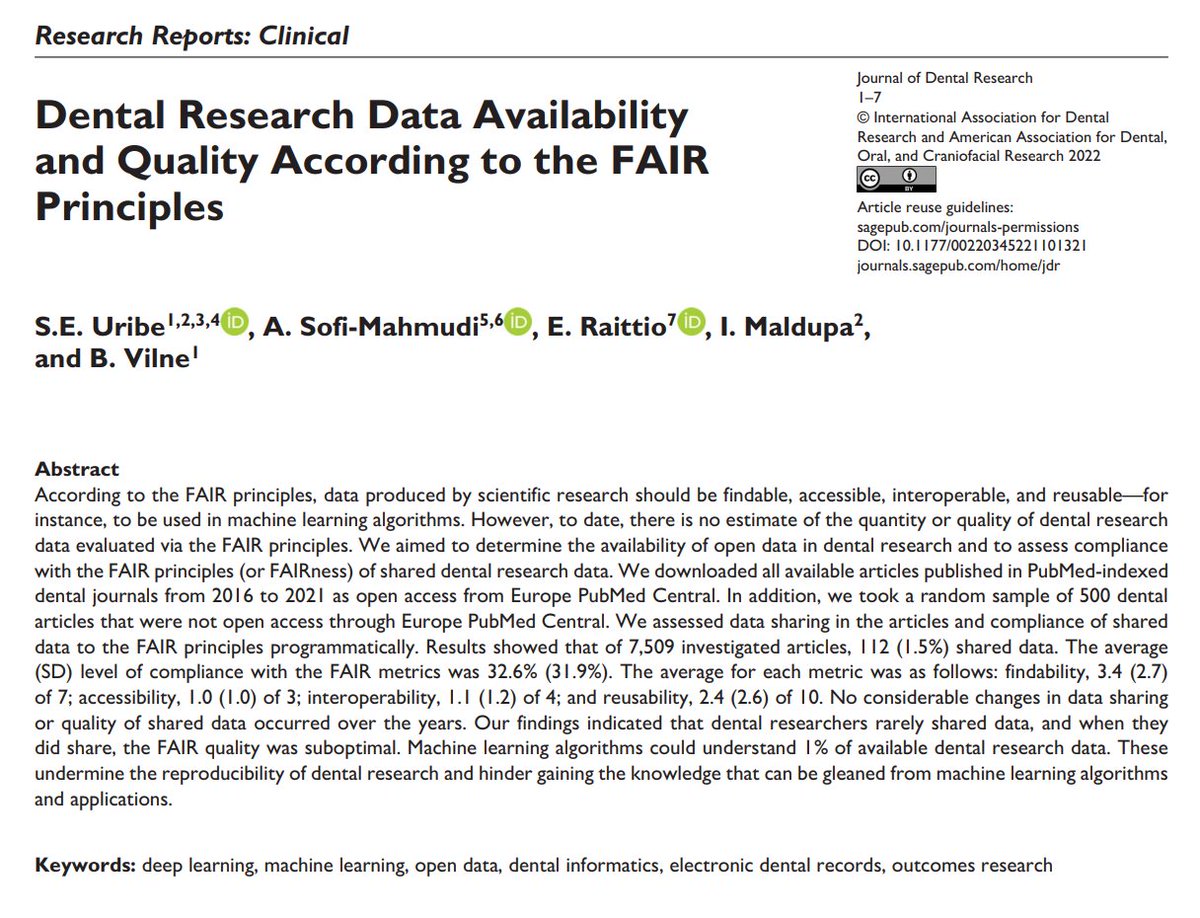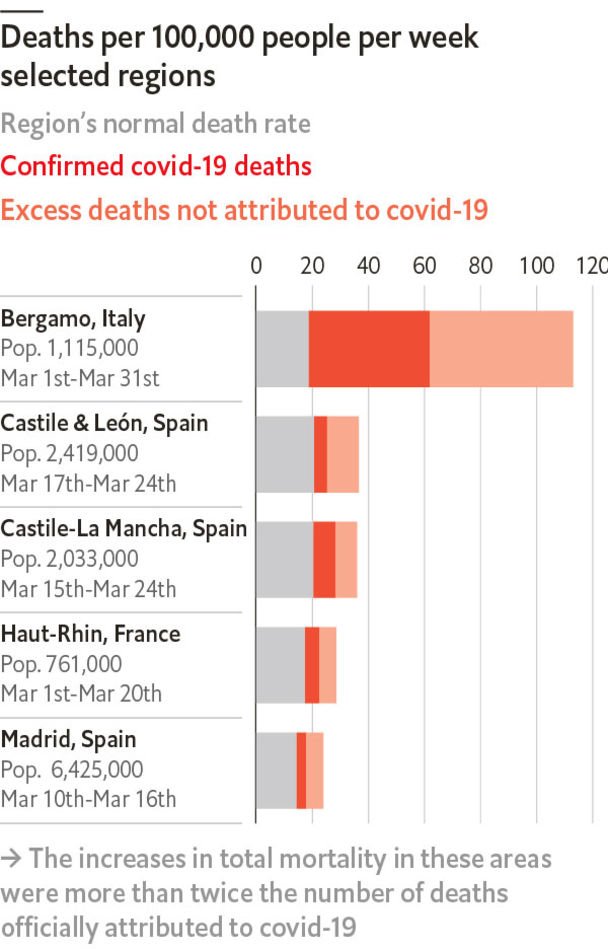1/ 🧵 Dental research generates data, but is data available and is machine-actionable?
That's the question we asked w/ @ASofiMahmudi @raittioe @IlzeMal & @baiba_vilne in #openaccess @JDentRes journals.sagepub.com/doi/full/10.11… thanks to @mikrotik_com & @bbcentre_eu #FAIR #openscience
That's the question we asked w/ @ASofiMahmudi @raittioe @IlzeMal & @baiba_vilne in #openaccess @JDentRes journals.sagepub.com/doi/full/10.11… thanks to @mikrotik_com & @bbcentre_eu #FAIR #openscience
2/ Raw data allows replication and validation of results. Additionally, if it is in a machine-accessible format, this would allow new hypotheses to be explored using the available data
#reproducibility #researchtransparency #opendata #FAIRdata
#reproducibility #researchtransparency #opendata #FAIRdata

3/ in order for machines to access data, it must be Findable, Accessible, Interoperable and Reusable. This is known as #FAIRdata 

4/ Sharing data in #FAIRdata allows other researchers to access it, but it is primarily intended for 🤖, as they see the data in a different way.
In this way they can catalog, process or reuse this data or join it with other data, maximizing the effects of the research.
In this way they can catalog, process or reuse this data or join it with other data, maximizing the effects of the research.

5/ Using tools created primarily by @SteliosSerghiou and @FAIRsFAIR_EU we programmatically analyzed the availability and quality of data available in dental publications @EuropePMC_news from 2016 to 2021. Thus we were able to evaluate how machines view the available research data
6/ We found that of 7 549 available publications, 112 (1.5%) shared research data; Table 1 shows the results by journal and year. Of 165 journals, we found data in only 21. We did not find a trend by year. 

7/ When evaluating compliance with FAIR criteria, we found that the average compliance was 32.6%. The items with the lowest compliance were reusability (24%) and interoperability (27%). #dentalFAIRdata 

8/ We observed that there was no clear trend in #FAIRdata compliance for dental publications between 2016 to 2021 nor for journals. #dentalFAIRdata 

9/ When analyzing the detail, the item with the least compliance refers to the description of the metadata and whether the data is in a format that can be reused (open format such as csv) or closed (such as xlsx, doc, etc). #dentalFAIRdata 

10/ What do these results mean? The fact that 98.5% of the research evaluated does not share data makes the measures being taken by major funding agencies such as @NIH, @UKRI_News, and @HorizonEU make sense and should be implemented urgently. #opendata #dentalFAIRdata 

11/ recent research @JClinEpi showed that even when authors put "Data available upon request" only 7% of contacted authors shared the data ( jclinepi.com/article/S0895-… ) so journals should start demanding data or authors justify why they can't share it. #opendata 

12/ On the other hand, the fact that the few data are shared in unstructured format instead of #FAIRdata hinders their use by other researchers, limiting their reproducibility as well as their machine-actionability. What can researchers do to improve this situation? 

13/ First of all learn about FAIR principles. A good guide is here openaire.eu/how-to-make-yo…, howtofair.dk or by asking at your research office.
14/ Before you begin your research, develop a data management plan. You can use @TheDMPTool or argos.openaire.eu/home from @OpenAIRE_eu
When you finish the research, make sure to deposit the data in repositories, such as @ZENODO_ORG , @figshare @OSFramework
When you finish the research, make sure to deposit the data in repositories, such as @ZENODO_ORG , @figshare @OSFramework

16/ Be sure to publish all #metadata, i.e., the data that indicates what the data is about. You can check for standards here from @FAIRsharing_org : fairsharing.org/search?fairsha… 

17/ When you publish your data, make sure that you clearly indicate whether you allow the use of the data and under what conditions by means of a license. 

18/ The fact that your data is #FAIRdata does not mean that everyone has access, and there may be conditions (confidentiality, commercial agreements) that may well limit access, but the *data should be as open as possible and as closed as necessary* 

19/ So when starting your research, plan your data management! You can use a tool like @TheDMPTool or argos.openaire.eu/home from @OpenAIRE_eu. 

20/ Then when publishing your raw data, you can verify compliance with the #FAIRdata principles using the @FAIRsFAIR_EU tool at fairsfair.eu/f-uji-automate… 

21/ When you share your data in FAIR format in repositories like @ZENODO_ORG or @OSFramework - @figshare - you ensure that your results can be independently replicated and validated, and that's just what doing science is all about! 

22/ The full report #openaccess at @JDentRes journals.sagepub.com/doi/full/10.11… and you can follow @FAIRsFAIR_EU @OpenSciTalk @InCollaboratory @SteliosSerghiou @EoscLife @resdatall @EmbassySci @GOFAIRofficial @OpenAIRE_eu #opendata #openscience to learn more about #fairdata
BONUS: this publication follows #openscience principles, with the protocol osf.io/zs5dk , final report journals.sagepub.com/doi/full/10.11… and dataset zenodo.org/record/6460190 published #openaccess 

BONUS Reviewers provided advice and comments that significantly improved the paper. Also, the attention to detail from @NickJakubovics, editor of the @JDentRes was amazing 🤩 check this 👇 

END/ Finally kudos to the great team of @ASofiMahmudi @raittioe @IlzeMal and @baiba_vilne and to the support through the @mikrotik_com research grant and the bbcentre_eu that made this #metaresearch possible. Download the full text here: journals.sagepub.com/doi/full/10.11…
ah, this research is part of a special issue of the @JDentRes about Data-Driven Dentistry, so stay tuned for more information. 

x/ in case you asked, this is the #FAIRness 🤖 of the dataset from this research Evaluation: f-uji.net/view/172 Dataset: zenodo.org/record/6460190 

Read in one unroll @threadreaderapp
• • •
Missing some Tweet in this thread? You can try to
force a refresh







